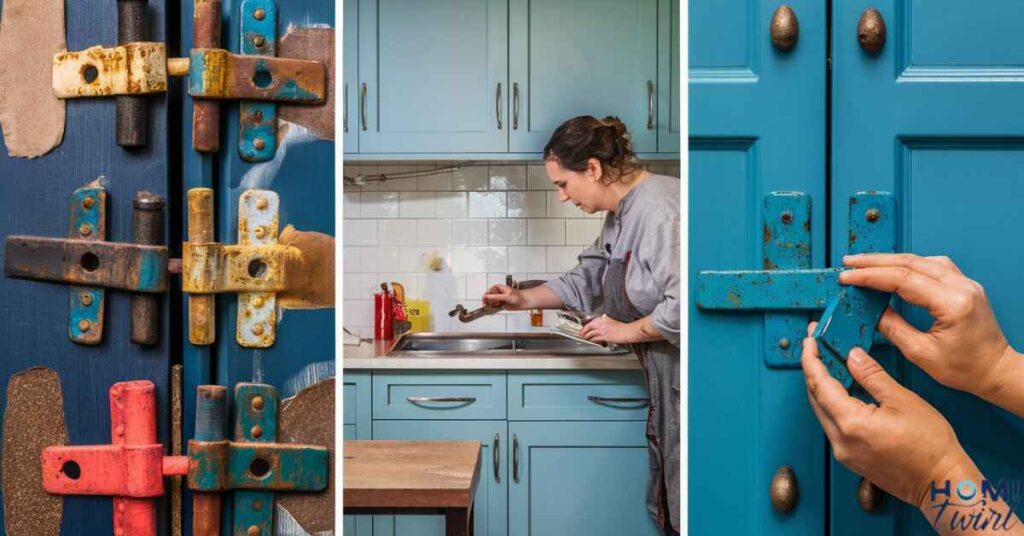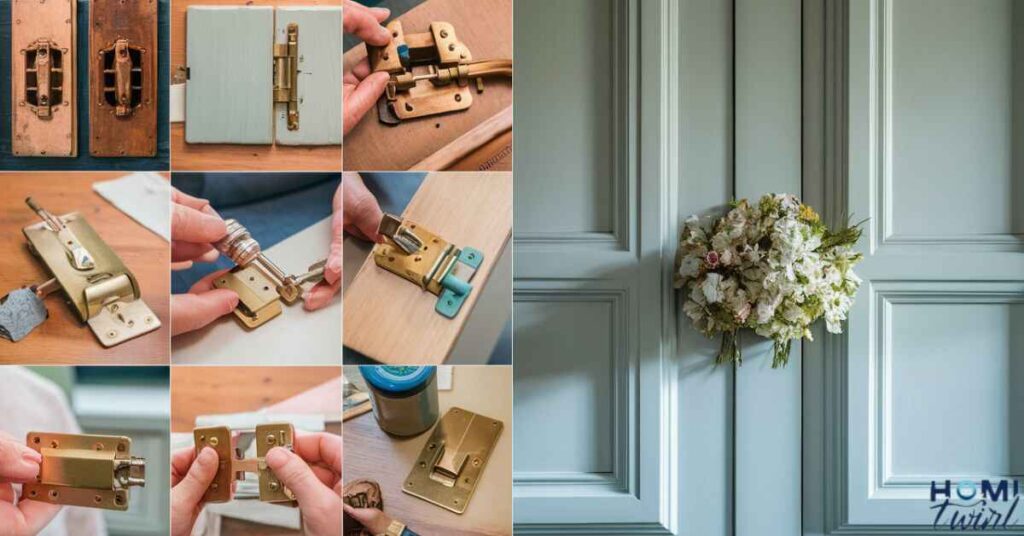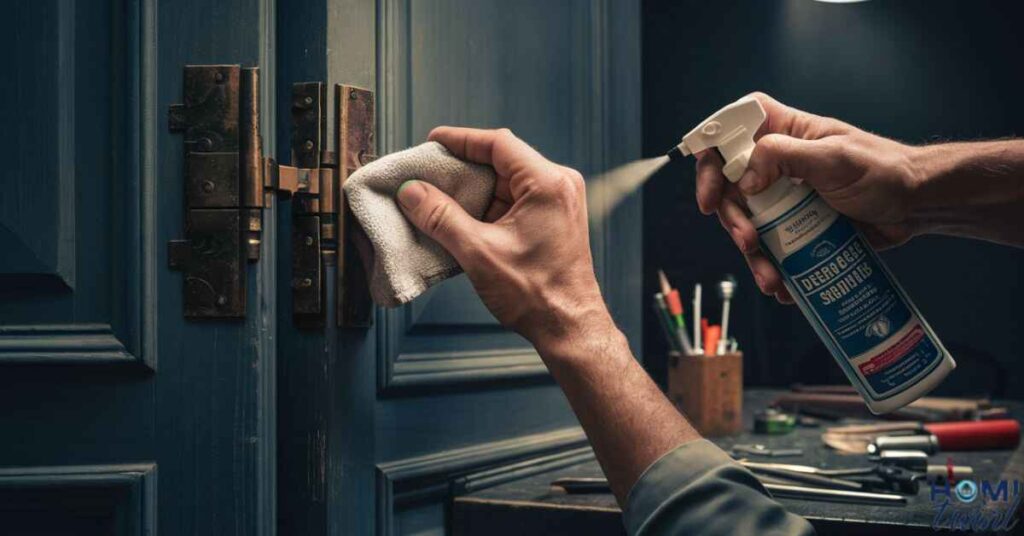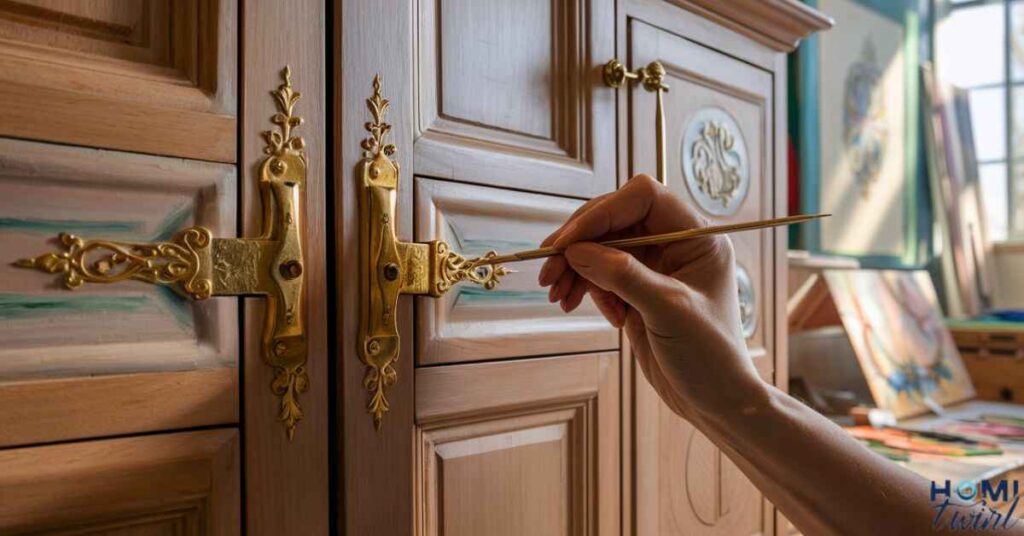Yes, you can paint hinges on cabinets to refresh their appearance without the expense of replacement. Painting hinges is a cost-effective way to update your cabinets while maintaining their functionality.
By following a few simple steps, you can achieve a brand new look for your cabinets. This process involves removing the hinges, stripping existing paint if necessary, cleaning off grease, sanding the surface for better adhesion.
painting with primer and enamel, and finally, applying a protective coat of clear lacquer.
Why Paint Cabinet Hinges Instead of Replacing?

There are several advantages to refinishing cabinet hinges over buying brand new ones:
- Cost Savings: A can of spray paint is much cheaper than purchasing all new hinges, especially if you have a lot of cabinets.
- Perfect Fit: The existing hinges already fit the drilled holes perfectly. Replacing them means having to re-drill holes or patch the old ones.
- Customization: With paint, you can choose any color to match or contrast with your new cabinet paint for a unique, personalized look.
- Environmental Impact: Reusing the hinges is more eco-friendly than throwing them out and buying new hardware.
Read This Blog: CAN YOU INSTALL CABINETS ON TOP OF VINYL PLANK FLOORING
What You’ll Need
Before starting your cabinet hinge makeover, gather these supplies and tools.
Supplies:
- Paint stripper (if existing hinges are painted)
- Denatured alcohol
- 220-grit sandpaper
- Metal primer spray paint
- Metal enamel spray paint in desired color
- Clear lacquer spray paint
Tools:
- Screwdrivers (flat and Phillips head)
- Respirator or painting mask
- Rubber gloves
- Steel wool pads
- Drop cloths or newspaper
- Small paint brushes (for tight areas)
- Zippered plastic bags (for storing screws)
Step-by-Step Process

Follow these steps carefully for best results when painting metal hinges:
1. Remove the Hinges
Using your screwdrivers, completely unscrew and remove all hinges from both the cabinet doors and cabinet boxes/frames. Be sure to store all screws safely in labeled zippered bags so you don’t lose or mix them up.
2. Strip Existing Paint (if needed)
If the hinges were previously painted, you’ll want to strip off that old paint first. Here’s how.
- Put on rubber gloves to protect your hands.
- Pour some paint stripper into a small bucket or container.
- Fully immerse each hinge in the stripper for 1-2 minutes.
- Remove and use a steel wool pad to scrub off any remaining paint.
- Rinse the stripped hinges thoroughly under running water to remove any stripper residue.
Work in a well-ventilated area and avoid skin/eye contact with paint strippers.
3. Clean and Degrease the Hinges

Whether the hinges were previously painted or not, it’s crucial to fully clean and degrease them before painting. Any grease, grime or oils on the surface will prevent new paint from properly adhering.
Also Read This Blog: ARE ONE DAY BATHROOM REMODELS WORTH IT
Simply wipe down all sides of the hinges using a clean rag dampened with denatured alcohol. Focus especially on the visible areas that will be painted. Allow hinges to fully dry before proceeding.
4. Lightly Sand the Visible Areas
Using 220-grit sandpaper, lightly sand just the areas of the hinges that will be visible once reinstalled. This rough sanding helps the new paint grip by creating a slightly textured surface. Avoid sanding any tight interior areas that paint won’t reach.
Wipe away any remaining sanding dust with a clean rag when finished.
5. Apply Primer and Paint Coats
With the hinges fully prepped, you’re ready to start painting! Lay them out on a protected flat surface like newspaper or a drop cloth.
Priming:
- Wearing a respirator, apply an even coat of metal primer spray paint to all visible hinge surfaces.
- Allow the primer to fully dry for 30-60 minutes before topcoating.
- If painting both sides, flip hinges and prime the opposite side as well.
Painting:
- Spray on your first coat of metal enamel paint in your desired color. Do one side at a time if painting both front and back.
- Let dry for 1 hour, then apply a second topcoat for full coverage.
- Don’t forget to also paint any exposed screw heads to match!
Use thin, even coats, keeping the spray can 6-10 inches from the surface and using a sweeping motion. Let paint dry completely between coats.
6. Add a Clear Lacquer Finish
For maximum durability and a professional finish, apply a clear acrylic lacquer once the final paint coat has fully dried (1-2 hours).
- Spray on a smooth, even coating of clear lacquer over all painted hinge surfaces.
- Let lacquer cure fully overnight before reassembling and reinstalling the hinges on your cabinets.
The lacquer creates a tough, long-lasting glossy topcoat that protects your new paint job from chipping, scratching or premature wear.
Pro Tips
- Work in a well-ventilated area when using any spray paints, primers or lacquers.
- Consider using painter’s tape to mask off any areas you don’t want painted.
- For an ultra-smooth finish, use high-quality brushes for cutting in tight areas.
- Plan to do all hinge painting in one session for best color matching across doors/cabinets.
- Look for paint+primer combination aerosol products to potentially skip the separate priming step.
Troubleshooting Common Issues

Dealing with drips or uneven coverage: Lightly sand problem areas after paint dries, wipe clean, then reapply thin topcoats as needed.
Fixing chipping or peeling paint: Remove any loose paint with a scraper or sanding, then recoat with a bonding primer before repainting.
Solving sticking or binding after reinstallation: Check for any excess paint buildup, then carefully sand down high points that are causing sticking. Apply a dry lubricant if needed.
Design Inspiration
Once you’ve mastered the DIY hinge painting technique, get creative with your color choices! Consider these ideas.
- Crisp black hinges on white cabinets for a classic, high-contrast look
- Metallic champagne or copper tones for a warm, luxe feel
- Bold accent colors like jade, coral or turquoise to make a statement
- Mix and match hinge colors to create complementary palettes (ie. navy and brass)
Don’t forget that you can also update other cabinet hardware like knobs and pulls to coordinate with your newly painted hinges for a full cabinet facelift.
Frequently Asked Question
Can I paint hinges without removing them?
It’s possible but not recommended; removing hinges ensures thorough coverage and prevents damage to surrounding surfaces.
Do I need to strip existing paint from the hinges?
If the paint is in good condition, you can scuff it up with sandpaper; otherwise, stripping ensures a smooth, long-lasting finish.
Can I use any type of paint on hinges?
Opt for metal-specific primer and enamel paints for durability and adhesion on metal surfaces.
How long does it take to paint hinges?
The process typically takes a day, including drying times between coats and overnight curing for the lacquer.
Can I paint hinges if they’re rusty?
Remove rust with a wire brush or rust remover before painting to ensure a clean surface and prevent future corrosion.
Should I paint both sides of the hinges?
Yes, for a uniform look, paint both sides, focusing on the most visible parts facing outward when installed.
Can I paint screws along with the hinges?
Yes, spray the screw heads on a flat surface along with the hinges for a cohesive appearance.
How do I ensure a professional-looking finish?
Proper surface preparation, even application of paint, and allowing adequate drying and curing times are key to a professional result.
Conclusion
painting cabinet hinges offers a budget-friendly way to revitalize your cabinets and enhance the overall aesthetics of your space. By following the outlined steps, including proper removal, cleaning, sanding, priming, painting, and lacquering, you can achieve a professional-looking finish that not only refreshes the appearance of your hinges but also adds a touch of elegance to your cabinets.
This process allows you to customize the color of your hinges to match your decor or create a striking contrast for visual interest. With attention to detail and patience during each step, you can transform your cabinets with a fresh, modern look that enhances the beauty and functionality of your space.







